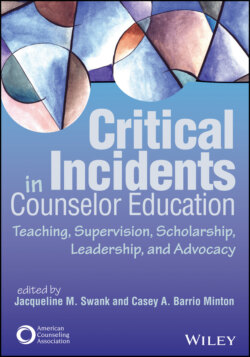Читать книгу Critical Incidents in Counselor Education - Группа авторов - Страница 43
2014 ACA Code of Ethics Standards Addressed
ОглавлениеF.1.a. Client Welfare
F.7.g. Student-to-Student Supervision and Instruction
F.8.c. Self-Growth Experiences
F.8.d. Addressing Personal Concerns
F.9.a. Evaluation of Students
F.9.b. Limitations
• • •
In a first-semester counseling skills class, master’s students routinely practiced basic microskills in triads, rotating the roles of counselor, client, and observer. On the first day of class, Professor X discussed the important role of the mock client, noting that students should come to class prepared to discuss real-life topics they were comfortable sharing. Topics such as substance use and trauma were off limits for role plays. This restriction was essential to assist students in developing professional boundaries as well as identifying areas in which personal concerns may intrude into the counseling relationship. Also, personal unfinished business might indicate issues that could use attention in personal counseling, which this course did not provide. Professor X indicated that if role-play practice sessions transitioned to such topics at any time, the client should hit the pause button on the dialogue and say they wanted to talk about something else. Professor X had the same responsibility while observing in-class practice sessions and providing live feedback. The course syllabus included details about these rules, including the expectation that students would notify Professor X if such incidents happened.
A few weeks into the semester, Professor X became concerned about Jessie while watching recordings of in-class practice sessions. Although the role play began on a simple topic—Jessie’s current lack of a romantic relationship—it transitioned to a history of sexual abuse she described in a detailed manner in a calm and matter-of-fact voice. The student in the counselor role looked uncomfortable and asked whether they should switch to another topic, which they did. Neither student discussed this incident with Professor X.
After seeing the video clip, Professor X emailed the students in this triad and asked to meet with them individually to discuss the recording. Jessie initiated the conversation with Professor X, saying she had realized after the fact that her history of sexual abuse might qualify as an off-limits topic. She added that she had received a lot of counseling and felt OK about sharing. Jessie said she thought it was helpful for her peer to hear “this sort of stuff” before practicum.
Professor X thanked Jessie for sharing her perspective. She appreciated that Jessie had received counseling and shared that many counselors have experienced hardships; the work they did on those issues in their own personal counseling was vital for their professional competence. Professor X also noted the importance of maintaining boundaries with clients. Discussing her personal history of abuse in such a detailed way could cause harm to a client who also might be traumatized. There were varying opinions on self-disclosure with clients; best practice at this stage of development suggested consulting first and disclosing deliberately and for the benefit of the client. Professor X shared that because self-disclosure can be a social habit and a more advanced skill, it was off limits in this course. Students were expected to maintain the same boundaries with their peers as they would with future clients. In fact, the class would review the topic of self-disclosure in the upcoming weeks. Professor X shared that she would like to see students asking in advance whether a topic was permissible; this expectation paralleled the expectation to consult when encountering ethical dilemmas.
Jessie said she had not thought of the possibility she might harm someone by sharing her history, and she was concerned she might have caused harm to her peers. She wanted to speak with them and apologize. Professor X let her know she would be meeting with them about it and encouraged her to be in direct discussion with her peers. In separate meetings with the other students, Professor X processed what it had been like for them when Jessie had begun discussing her trauma history and asked what it would have been like for them to notify her about it. Both students shared feeling uncomfortable, overwhelmed, and out of their depth. They also worried about getting Jessie in trouble. Professor X thanked them for sharing their experience and expressed how important consulting was. Professor X stated that the priority was learning and growing; if she had not known this had happened, there would have been no opportunity for growth.
The following week during practice sessions, a student came to get Professor X, saying it was urgent. When Professor X arrived, one student was crying and another was consoling her while Jessie was sitting in the practice room alone. During the role-play session, Jessie had brought up the topic of her trauma history again and seemed to be on autopilot discussing details of the abuse. She said it was not on purpose, and it seemed to happen before she realized it. Professor X asked if someone would go see if other professors were in their office and could join them. Professor Y came and consulted with the crying student while Professor X spoke with Jessie.
Professor X expressed concern that this had happened again. Jessie seemed numb and detached when responding, not answering directly. Jessie said she would contact her counselor the next day and asked whether she would be kicked out of the program. Professor X shared that dismissing a student was a last resort and there were other options to consider. As class ended, Professor X said that it was important that she consult with other faculty and that she would be in touch to set up a time to meet. Before leaving, she confirmed that Jessie had a support she could contact.
